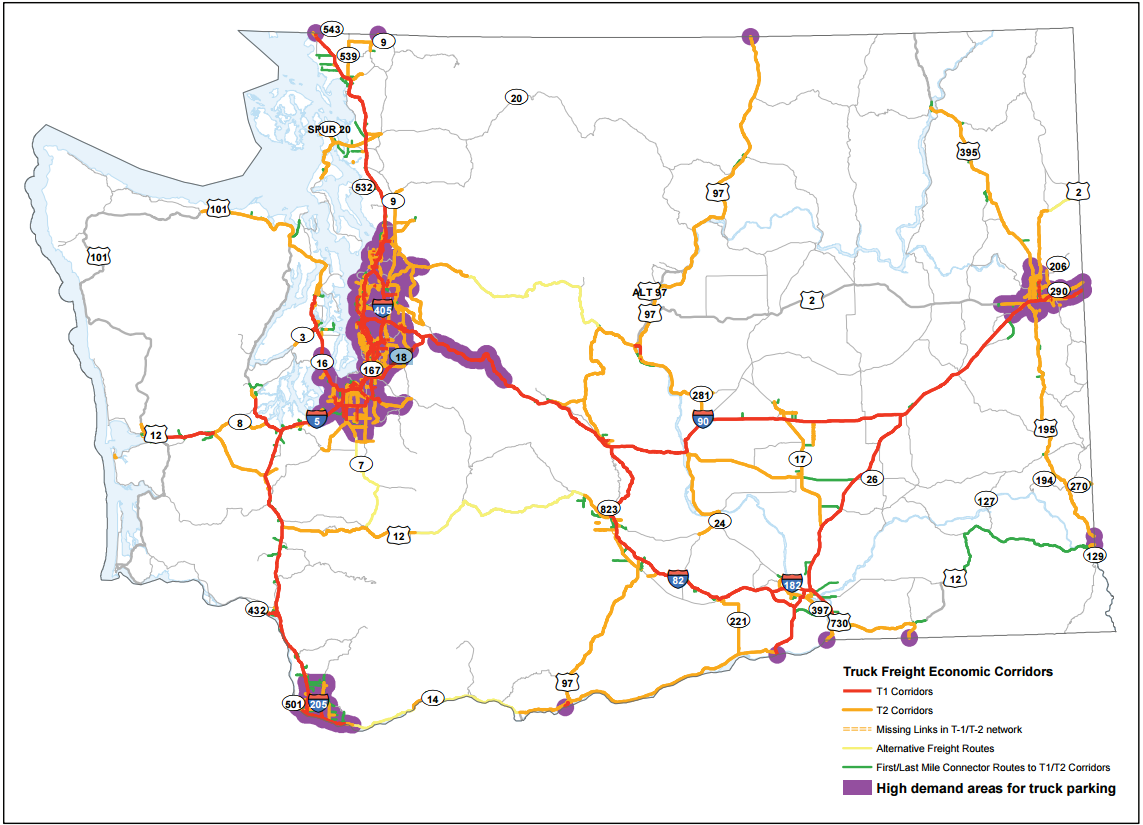
The State of Washington Truck Parking Study
posted in Alerts by Brian Gray
The State of Washington Truck Parking Study
The American Transportation Research Institute (ATRI) named two Washington cities, Seattle and Auburn, in the top 25 most congested freight locations in the U.S. Both cities experience significant freight bottlenecks and increased demand for parking. Washington also has five international border crossings, two of which the U.S. Department of Transportation (USDOT) lists in the top 15 international border crossings with the slowest speeds.
With 64.3 percent of freight in Washington transported by truck, it is crucial that drivers have safe and available parking options to support economic competitiveness. The Washington State Department of Transportation (WSDOT) initiated the 2016 Truck Parking Study to better understand and address truck parking and rest facility issues within the state.
The types of truck parking considered in the study include ten-hour rest breaks, thirty-minute rest breaks, urban local delivery parking, truck storage and incident-based truck parking.
THE STATE OF FREIGHT AND TRUCK PARKING IN WASHINGTON
According to the study, there are 14 high-volume truck freight economic corridors in Washington state, each carrying at least four million tons of freight each year. Washington’s economy is forecasted to grow 65 percent between 2015 and 2045, at an average annual growth rate of 1.7 percent. Continued growth in truck traffic volume is expected to put more pressure on current truck parking facilities.
Congestion and slow border crossings decrease the productivity of truck drivers within their hours-of-service regulations, subsequently affecting demand for parking. Industry changes, such as just-in-time logistics, operational costs and driver detention, all have significant effects on truck parking demand. State and federal regulations can also influence demand, such as insurance requirements and hours-of-service protocols.
KEY FINDINGS OF THE STUDY
WSDOT identified key truck parking issues in Washington. Safety issues related to inadequate truck parking are a major concern; 46 percent of WSDOT survey respondents said they frequently drive fatigued as a result of insufficient parking. In addition, 59 percent of drivers frequently do not feel safe while parked overnight in Washington.
WSDOT’s truck parking survey also found that Washington’s top three corridors with unmet parking demand are I-5, I-405 and I-90. They found that urban areas and at border crossings and mountain passes are the most prevalent areas for parking issues. WSDOT also determined that drivers’ parking preferences do not always match with actual use.
For example, highway exit and entrance ramps are one of drivers’ least preferred parking options but are third most used.
OPPORTUNITIES FOR WASHINGTON
WSDOT has identified several opportunities for truck parking enhancement, including infrastructure enhancements, institutional resources, and funding sources.
Infrastructure enhancements include emerging technologies, such as real-time parking availability systems, and innovative supply expansion options in both the private and public sector.
Institutional opportunities enhance understanding of the state of truck parking through data gathering and research, as well as through the formation and continuation of key partnerships.
Finally, identifying financial opportunities allows stakeholders to identify and pursue potential funding sources to enhance truck parking. For example, the Federal Fixing America’s Surface Transportation (FAST) Act, USDOT Transportation Investment Generating Economic Recovery (TIGER) grants and the Diesel Emissions Reduction Act (DERA) can all potentially be used to fund truck parking projects.
There are also opportunities for truck parking to pay for itself. Both private and public entities can make investments in truck parking facilities that can be maintained through truck parking fees or other revenue.
NEXT STEPS FOR WASHINGTON
Truck parking will continue to be an issue in Washington and additional efforts will be needed beyond the scope of this study. No one entity can address this growing concern alone and it will take strong partnerships to meet this truck parking challenge. WSDOT will incorporate the research collected for this study into its 2017 Freight System Plan.
In the future, WSDOT will continue current partnerships and establish new partnerships with state, federal and other public entities, industry associations, researchers and local communities to enhance understanding and work toward truck parking solutions.
For downloadable maps, click on the links below:
- Statewide map http://www.wsdot.wa.gov/NR/rdonlyres/46AC324A-D1CA-424E-8AC6-6279468031E3/0/TruckParkingMap_11x17_v13.pdf
- I5 Corridor Map http://www.wsdot.wa.gov/NR/rdonlyres/D2E243E5-979D-46BC-9ECE-22207AD5DB43/0/I5TruckFacilities_WEB_v4.pdf
- I90 East/West 82 182 Corridor http://www.wsdot.wa.gov/NR/rdonlyres/00570B92-6748-494F-9C33-C819C517F9A2/0/I90_I82_I182_TruckFacilities_WEB_v2.pdf






